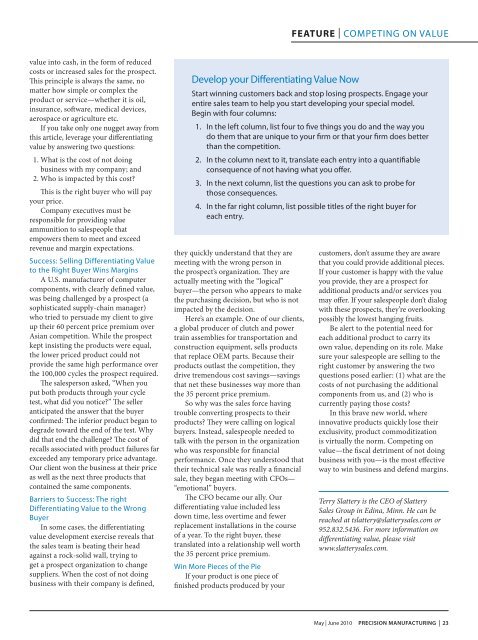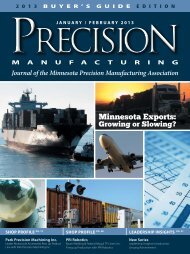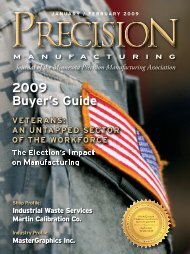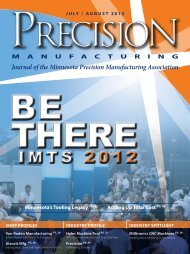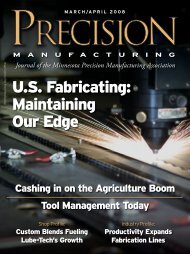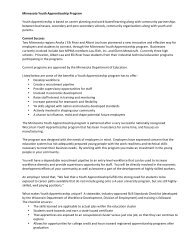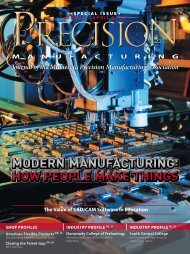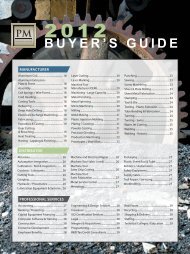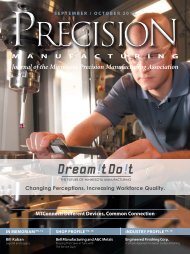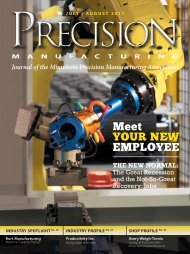Living in a materiaL worLd - Minnesota Precision Manufacturing ...
Living in a materiaL worLd - Minnesota Precision Manufacturing ...
Living in a materiaL worLd - Minnesota Precision Manufacturing ...
Create successful ePaper yourself
Turn your PDF publications into a flip-book with our unique Google optimized e-Paper software.
Feature | COMPETING ON VALue<br />
value <strong>in</strong>to cash, <strong>in</strong> the form of reduced<br />
costs or <strong>in</strong>creased sales for the prospect.<br />
This pr<strong>in</strong>ciple is always the same, no<br />
matter how simple or complex the<br />
product or service—whether it is oil,<br />
<strong>in</strong>surance, software, medical devices,<br />
aerospace or agriculture etc.<br />
If you take only one nugget away from<br />
this article, leverage your differentiat<strong>in</strong>g<br />
value by answer<strong>in</strong>g two questions:<br />
1. What is the cost of not do<strong>in</strong>g<br />
bus<strong>in</strong>ess with my company; and<br />
2. Who is impacted by this cost?<br />
This is the right buyer who will pay<br />
your price.<br />
Company executives must be<br />
responsible for provid<strong>in</strong>g value<br />
ammunition to salespeople that<br />
empowers them to meet and exceed<br />
revenue and marg<strong>in</strong> expectations.<br />
Success: Sell<strong>in</strong>g Differentiat<strong>in</strong>g Value<br />
to the Right Buyer W<strong>in</strong>s Marg<strong>in</strong>s<br />
A U.S. manufacturer of computer<br />
components, with clearly def<strong>in</strong>ed value,<br />
was be<strong>in</strong>g challenged by a prospect (a<br />
sophisticated supply-cha<strong>in</strong> manager)<br />
who tried to persuade my client to give<br />
up their 60 percent price premium over<br />
Asian competition. While the prospect<br />
kept <strong>in</strong>sist<strong>in</strong>g the products were equal,<br />
the lower priced product could not<br />
provide the same high performance over<br />
the 100,000 cycles the prospect required.<br />
The salesperson asked, “When you<br />
put both products through your cycle<br />
test, what did you notice?” The seller<br />
anticipated the answer that the buyer<br />
confirmed: The <strong>in</strong>ferior product began to<br />
degrade toward the end of the test. Why<br />
did that end the challenge? The cost of<br />
recalls associated with product failures far<br />
exceeded any temporary price advantage.<br />
Our client won the bus<strong>in</strong>ess at their price<br />
as well as the next three products that<br />
conta<strong>in</strong>ed the same components.<br />
Barriers to Success: The right<br />
Differentiat<strong>in</strong>g Value to the Wrong<br />
Buyer<br />
In some cases, the differentiat<strong>in</strong>g<br />
value development exercise reveals that<br />
the sales team is beat<strong>in</strong>g their head<br />
aga<strong>in</strong>st a rock-solid wall, try<strong>in</strong>g to<br />
get a prospect organization to change<br />
suppliers. When the cost of not do<strong>in</strong>g<br />
bus<strong>in</strong>ess with their company is def<strong>in</strong>ed,<br />
Develop your Differentiat<strong>in</strong>g Value Now<br />
Start w<strong>in</strong>n<strong>in</strong>g customers back and stop los<strong>in</strong>g prospects. Engage your<br />
entire sales team to help you start develop<strong>in</strong>g your special model.<br />
Beg<strong>in</strong> with four columns:<br />
1. In the left column, list four to five th<strong>in</strong>gs you do and the way you<br />
do them that are unique to your firm or that your firm does better<br />
than the competition.<br />
2. In the column next to it, translate each entry <strong>in</strong>to a quantifiable<br />
consequence of not hav<strong>in</strong>g what you offer.<br />
3. In the next column, list the questions you can ask to probe for<br />
those consequences.<br />
4. In the far right column, list possible titles of the right buyer for<br />
each entry.<br />
they quickly understand that they are<br />
meet<strong>in</strong>g with the wrong person <strong>in</strong><br />
the prospect’s organization. They are<br />
actually meet<strong>in</strong>g with the “logical”<br />
buyer—the person who appears to make<br />
the purchas<strong>in</strong>g decision, but who is not<br />
impacted by the decision.<br />
Here’s an example. One of our clients,<br />
a global producer of clutch and power<br />
tra<strong>in</strong> assemblies for transportation and<br />
construction equipment, sells products<br />
that replace OEM parts. Because their<br />
products outlast the competition, they<br />
drive tremendous cost sav<strong>in</strong>gs—sav<strong>in</strong>gs<br />
that net these bus<strong>in</strong>esses way more than<br />
the 35 percent price premium.<br />
So why was the sales force hav<strong>in</strong>g<br />
trouble convert<strong>in</strong>g prospects to their<br />
products? They were call<strong>in</strong>g on logical<br />
buyers. Instead, salespeople needed to<br />
talk with the person <strong>in</strong> the organization<br />
who was responsible for f<strong>in</strong>ancial<br />
performance. Once they understood that<br />
their technical sale was really a f<strong>in</strong>ancial<br />
sale, they began meet<strong>in</strong>g with CFOs—<br />
“emotional” buyers.<br />
The CFO became our ally. Our<br />
differentiat<strong>in</strong>g value <strong>in</strong>cluded less<br />
down time, less overtime and fewer<br />
replacement <strong>in</strong>stallations <strong>in</strong> the course<br />
of a year. To the right buyer, these<br />
translated <strong>in</strong>to a relationship well worth<br />
the 35 percent price premium.<br />
W<strong>in</strong> More Pieces of the Pie<br />
If your product is one piece of<br />
f<strong>in</strong>ished products produced by your<br />
customers, don’t assume they are aware<br />
that you could provide additional pieces.<br />
If your customer is happy with the value<br />
you provide, they are a prospect for<br />
additional products and/or services you<br />
may offer. If your salespeople don’t dialog<br />
with these prospects, they’re overlook<strong>in</strong>g<br />
possibly the lowest hang<strong>in</strong>g fruits.<br />
Be alert to the potential need for<br />
each additional product to carry its<br />
own value, depend<strong>in</strong>g on its role. Make<br />
sure your salespeople are sell<strong>in</strong>g to the<br />
right customer by answer<strong>in</strong>g the two<br />
questions posed earlier: (1) what are the<br />
costs of not purchas<strong>in</strong>g the additional<br />
components from us, and (2) who is<br />
currently pay<strong>in</strong>g those costs?<br />
In this brave new world, where<br />
<strong>in</strong>novative products quickly lose their<br />
exclusivity, product commoditization<br />
is virtually the norm. Compet<strong>in</strong>g on<br />
value—the fiscal detriment of not do<strong>in</strong>g<br />
bus<strong>in</strong>ess with you—is the most effective<br />
way to w<strong>in</strong> bus<strong>in</strong>ess and defend marg<strong>in</strong>s.<br />
Terry Slattery is the CEO of Slattery<br />
Sales Group <strong>in</strong> Ed<strong>in</strong>a, M<strong>in</strong>n. He can be<br />
reached at tslattery@slatterysales.com or<br />
952.832.5436. For more <strong>in</strong>formation on<br />
differentiat<strong>in</strong>g value, please visit<br />
www.slatterysales.com.<br />
May | June 2010 PRECISION MANUFACTURING | 23


